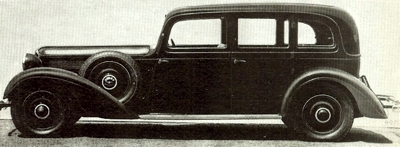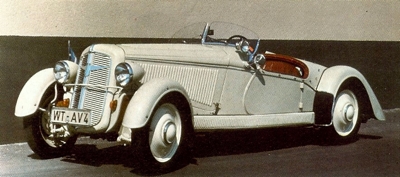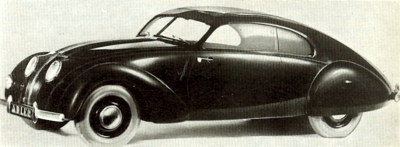Adler is German for 'eagle', a bird long associated with the Fatherland's Imperial aspirations. The Adler car, however, was seldom ambitious; rather it epitomised stolid Teutonic worth, being of sound 'bread and butter' design through most of its 40-year life, though showing unexpected vigour near the end.
Like many other early marques, Adler, of Frankfurt-am-Main, was a well-established bicycle manufacturer before the company turned to horseless carriages. Proprietor Heinrich Kleyer had been producing Adler cycles since 1886, and his first link with the new
automobile world was a contract to supply wire wheels to Benz for that company's spidery Velo motor
carnages.
Meanwhile, an Aachen engineer, Max Cudell, had secured successive licences from France to build de Dion-Bouton engines in 1897, tricycles in 1898 and voiturettes in 1899, all of which taxed the productive capacity of his factory. Kleyer undertook to build a batch of the tricycles for Cudell and when, during a visit to Paris in 1899, he saw Louis Renault's new voiturette, he was so attracted by it that he resolved to start building cars of his own.
The first Adler car emerged in 1900, and not surprisingly it closely resembled the Renault, right down to the vertical, front-mounted de Dion single-cylinder engine, the tubular chassis and propeller shaft drive to the rear wheels. The body was a
vis-cl-vis (face to face) four-seater, and the driver steered by a tiller on a vertical column.
Kleyer's little car was well made and could reach 18 mph; he lost no time getting it into production, and the '3.5 PS' sold well. Soon the factory positively hummed with activity, as Kleyer had also gone in for motorcycle manufacture, and the car trade was booming. By 1903 the range had been augmented by larger 4.5 and 8 hp de Dion-engined cars with proper
steering wheels and semi-elliptic springs in place of the fully-elliptic type used previously.
Otto Julius Bierbaum
The 8 hp Adler had a de Dion-style 'coal scuttle' bonnet, a
radiator slung low at the front and a column- mounted gearchange. Its 865 cc single-cylinder de Dion engine drove through a three-speed gearbox fitted with reverse, and it was a sturdy car with a good reputation. This was greatly enhanced by the well- known writer and traveller Otto Julius Bierbaum who, with his wife and chauffeur, made an extensive, trouble-free tour from Germany across the Alps into Italy, and then wrote a book about it.
Kleyer's next step was for Adler to manufacture single and twin-cylinder engines. At first these tended to follow the de Dion pattern with automatic inlet valves, but with the arrival in 1903 of a new engineer from Bohemia, Edmund Rumpler, the engines soon developed a character of their own. They also grew larger, a 12 hp twin and a 24hp four-cylinder unit joining the rapidly widening Adler range.
Some of Rumpler's more radical ideas, such as the independent rear swing axles he patented in 1903, were repressed by the practical Kleyer, who sought only to consolidate Adler's reputation for building dependable, un- complicated motor cars. Rumpler's swing axles remained unappreciated until after World War I, long after he had left the employ of Adler.
One innovation of Rumpler's which Kleyer did adopt for a few years, however, was the gearbox built in unit. with the engine, first seen on a large new Adler prestige model, the 7. 5-litre 40/50, at the 1905 Frankfurt Show. Like most makes at that time, Adler competed in speed hillclimbs, reliability runs and occasional races, such as the 1907
Kaiserpreis, albeit with small success.
In 1908, however, two 7.2-litre Adler cars came jrd and 5th out of 144 runners in the r aoo-mile Prince Henry Cup Trials, which started in Berlin and finished seven days later in Arller's home town, Frankfurt. Only a 7.s-litre Benz and a big Mercedes headed them, both with top-flight works drivers. The Adlers continued to do quite well in subsequent trials, and up to 1914 the Adler range proliferated enormously, with over thirty models catalogued, ranging from 9 hp twins to 12, 15, 20, 25, 30, 40, 45, and 65 hp four-cylinder cars.
Most of these were built for reliable service rather than performance, but rare examples included the 1910 'Prince Henry' with 5.2- litre ohv engine, shapely open 4-seater body and an 80 mph maximum; the sporting KL 8/22 side-valve of 1912-14, with an open body of Prince Henry derivation; and a 3.3-litre overhead-valve sports model, three of which ran unsuccessfully in the 1914 TT race in the Isle of Man.
 This image shows the Adler Diplomat of 1928. It was powered by a three litre six cylinder engine and had rear-wheel drive with independent front suspension.
This image shows the Adler Diplomat of 1928. It was powered by a three litre six cylinder engine and had rear-wheel drive with independent front suspension.
 The Adler Trumpf looked the goods, pictured here is a 1 litre Trumpf Junior Sports model which had independent suspension and front wheel drive. They proved very popular for competition work.
The Adler Trumpf looked the goods, pictured here is a 1 litre Trumpf Junior Sports model which had independent suspension and front wheel drive. They proved very popular for competition work.
 This image shows the revolutionary 2.5 litre with streamlier style body obviously developed in a wind tunnel. Power came from a straight six, and the car first saw the light of day in 1937, but the war soon put an end to Adler vehicle production - a halt from which the company would never recover.
This image shows the revolutionary 2.5 litre with streamlier style body obviously developed in a wind tunnel. Power came from a straight six, and the car first saw the light of day in 1937, but the war soon put an end to Adler vehicle production - a halt from which the company would never recover. |
Widely Exported Before World War 1
Adlers were widely exported before World War 1, being popular in South Africa, the East Indies and elsewhere. They enjoyed a steady sale in Britain, distributed by Morgan and Co Ltd, a coach-building concern centred at Leighton Buzzard. Such outlets ceased, of course, after the war and Adler's recovery, like that of Germany as a whole, was slow. The company revived the pre-war medium fours, then introduced more modern 1.5, 2.3 and 3.1-litre models.
The Adler Favorit, and Hydraulic Brakes
In 1925 Adler built the company's first six-cylinder cars in 2.6 and 4.7-litre form, and in 1929 came the 1.9- litre four-cylinder Favorit with hydraulic brakes. That year also saw the first Adler eight-cylinder car, a solid American-style 3.9-litre side-valve unit fitted in a car called the Standard 8, which was hydraulic- braked and closely resembled the Chrysler. It was, in fact, around that time of shaky German economics that talks were initiated between Erwin Kleyer, who succeeded his father as head of the concern, and Chrysler of America, with a view to a dollar take-over.
The Adler Trumpf
Then came news of General Motors' acquisition of Opel and the controlling Deutsche Bank halted the Chrysler-Adler negotiations. 1930 brought Adler into the last and most adven- turous decade, for a new broom in the person of Hans-Gustav Rohr swept the design office clean of old ideas and produced a daring new small car with front-wheel drive, all-independent springing, punt-type chassis with welded-on bodywork, and rack-and-pinion steering. It was called the Adler Trumpf (meaning trump) and despite its modest 1.5-litre side-valve four-cylinder engine, its agility and cornering power were remarkable for the time.
The Trumpf was in full production by 1933, preceding Citroen's more famous front-drive car by a year, and Rosengart of France and Imperia of Belgium built the Trumpf under licence. A 1.7-litre engine option was added and the car was imported into Ireland, where in 1934 its nimble
handling gained it road race wins at Bray and Skerries. Other Adler models were the Trumpf-engined Primus and the handsome 3-litre Diplomat six, both with rear-wheel drive and independent front suspension.
The Adler Rennlimousin
Then the company announced the 996 cc Trumpf-Junior, followed by front-wheel drive sports models with three engine sizes in lowered chassis, with aluminium
cylinder heads and cycle-type wings over the wheels. These pretty little cars looked faster than they really were, yet were lively enough to score several competition successes. In an effort to offset modest engine performance by
aerodynamic efficiency, Adler next produced the company's famous
Rennlimousin, clothing the normal chassis in a beautiful, fully streamlined closed body, which aided in the breaking of many long-distance class records in 1935 and 1936.
In sports car racing, three of these sleek saloons scored 1-2-3 in the z-litre class of the 1936 Belgium 24 Hours, were first in class at Le Mans in 1937 and won the Index award and the 5-litre class there in 1938. The company applied the lessons it had learned and provided a range of improved and very shapely cars-the new Trumpf and Trumpf-Junior, the Diplomat, and new 2-litre and 2.5-litre models, the latter with six-cylinder engines and a most advanced, wind tunnel-developed, saloon body.
However, 1939 saw an end to the production of Adler cars. During World War 2 the plant at Frankfurt was almost totally destroyed and although Adler planned to revive the Trumpf range with the return of peace, a sudden management order came not to build any more cars. Many believed this was the result of a tacit agreement with another car manufacturer to avoid competition. Whatever the real reason, the rebuilt factory, situated in a street renamed Kleyer-Strasse in tribute to Adler's founder, reverted temporarily to motorcycle manufacture and more permanently to typewriters - for which the company would become world-famous - as a member of the Grundig group. This in turn would be taken over by Olivetti in 1957, by which time the Adler automobiles were long forgotten.



